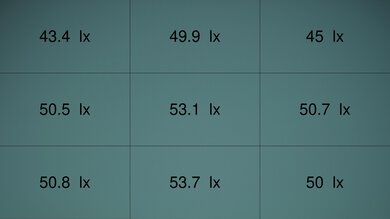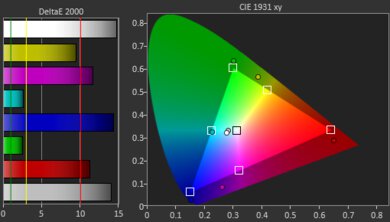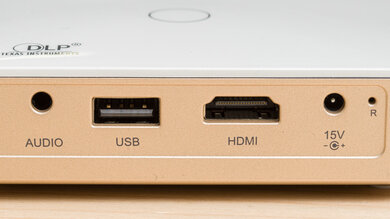The KODAK LUMA 350 is a basic 480p portable pocket projector. It's designed to be small enough to fit in your pockets, and its integrated battery lets you take it with you easily. It even has auto vertical keystone correction, making it fast and easy to set up when you move it. The LUMA 350 is capable of projecting images of up to 150". It's designed to quickly share media from your phone or mobile device over a wide selection of inputs, including USB, HDMI, or through the projector's casting and mirroring capabilities via DLNA or Miracast. It's Wi-Fi and Bluetooth enabled, has the Android OS smart interface, and has built-in dual 1.5W speakers.
Our Verdict
The KODAK LUMA 350 portable smart projector is a poor choice for watching movies. Its brightness is awful, so it isn't usable in anything but the darkest of rooms, although it's still disappointing in that context due to its middling contrast. It also has terrible pre-calibration accuracy, and there's no way to calibrate it, so you're stuck with the terrible colors it comes with. However, it's extremely portable due to its size, smart features, and integrated battery.
-
Extremely portable due to its size, smart features, Wi-Fi/Bluetooth support, and integrated battery.
-
Terrible brightness; it's so dim you can barely see the image unless the room is pitch black.
-
Abysmal color accuracy out of the box, and the projector has no calibration features.
-
Middling contrast leads to disappointing dark room performance.
- 4.5 Movies
- Updated Aug 07, 2024: Mentioned the newly-reviewed LG CineBeam PF50KA in the Projector Technology section of this review.
- Updated Aug 05, 2024: Updated text throughout the review according to Test Bench 0.9, mainly in the Verdict, Compared To Other Projectors and Contrast sections.
- Updated Aug 02, 2024: We've converted this review to Test Bench 0.9. We've overhauled our Contrast tests, as we now measure contrast at various average pixel levels (APL). You can see the full changelog here.
- Updated Feb 28, 2024: Review published.
- Updated Feb 17, 2024: Early access published.
Differences Between Sizes And Variants
We bought and tested the KODAK LUMA 350 projector. It's the mid-tier model in KODAK's LUMA range of projectors, which includes the cheaper KODAK LUMA 75 and KODAK LUMA 150 and the more expensive KODAK LUMA 400 and KODAK LUMA 450.
| Model | Bluetooth | Resolution | Cast Capable | Wi-Fi | Tripod In Box | Auto Keystone |
|---|---|---|---|---|---|---|
| LUMA 75 | No | 360p | No | No | No | No |
| LUMA 150 | No | 480p | No | Yes | No | No |
| LUMA 350 | Yes | 480p | Yes (DLNA) | Yes | No | Yes (vertical) |
| LUMA 400 | Yes | 720p | Yes (DLNA) | Yes | Yes | Yes (vertical) |
| LUMA 450 | Yes | 1080p | Yes (DLNA) | Yes | Yes | Yes (vertical) |
Compared To Other Projectors
This projector is a poor choice for watching movies, but it is extremely small and has an integrated battery, so it can serve as a pocketable projector that you can easily bring around. It's a much better choice than the KODAK LUMA 150, as it's much brighter (even if still dim) with vastly better contrast, has auto vertical keystone correction, Bluetooth support, and is cast capable through DLNA. Still, if you don't need the integrated battery, opt for the much better XGIMI MoGo 2; just make sure to bring a portable battery pack, as the XGIMI doesn't come with an integrated battery.
Check out our recommendations for the best portable projectors and the best outdoor projectors. If you'd prefer to shop for another product in the same price range, look up the best projectors under $500 instead.
The BenQ HT2050A is much better than the KODAK LUMA 350, but they're significantly different projectors. The KODAK is an ultra-lite projector and is meant to be extremely easy to carry around. The BenQ is a bigger projector that is meant for you to install permanently. The BenQ has vastly better image quality. However, the KODAK is small and has more smart features, like an integrated Android TV OS, Wi-Fi, and Bluetooth support, cast capabilities through DLNA, and auto vertical keystone correction.
The Epson Home Cinema 5050UB is far better than the KODAK LUMA 350, but they serve different purposes. The KODAK is an ultra-lite projector and is meant to be extremely easy to carry around, while the Epson is a much bigger projector that is meant for you to permanently install it. The Epson has vastly better image quality. However, the KODAK is small and has more smart features, like an integrated Android TV OS, Wi-Fi and Bluetooth support, cast capabilities through DLNA, and auto vertical keystone correction.
The KODAK LUMA 350 is better than the KODAK LUMA 150, and between the two, the 350 is the projector to get if you need an ultra-portable battery-equipped device. They both have awful color accuracy that you can't improve through calibration. However, the LUMA 350 is brighter, has better contrast, a wider color gamut, a slightly higher output resolution, Bluetooth support, and is cast capable through DLNA.
The Epson EpiqVision Flex CO-W01 is much better than the KODAK LUMA 350. The Epson is much brighter and vastly more accurate than the KODAK. Still, the KODAK is a small ultra-portable projector with an integrated battery, while the Epson is a bigger but still somewhat portable unit, although you need to plug it into an outlet. If you need a super-light projector with a battery, go for the KODAK, but the Epson is the better buy for all other purposes.
The XGIMI MoGo 2 is better than the KODAK LUMA 350, as the XGIMI offers better image quality in any room context. Still, while they're both portable projectors, the KODAK is much smaller than the XGIMI, and comes with an integrated battery. So, if you need a projector that you can easily fit in your pockets the KODAK is the better option, but the XGIMI easily fits into a backpack; just make sure you have a portable battery pack.
The WiMiUS P63 and KODAK LUMA 350 are equally good but have different strengths. The KODAK is incredibly portable and small enough to put in your pockets. The WiMiUS is also portable due to its relatively small size and auto keystone correction feature, although the KODAK also has that. The KODAK has a surprisingly wide color gamut compared to the very limited WiMiUS, but it doesn't really matter, as the two projectors are too dim to make colors pop. The WiMiUS P63 has the better contrast, so it gets the clear edge when used in a dark room.
The KODAK LUMA 350 and LG CineBeam PF50KA are about equally good, although the KODAK is significantly smaller; it's so small you can put it in your pocket. The LG is otherwise extremely portable, but not to the point of being pocketable. Regarding image quality, the two projectors are quite bad, so ultimately, the KODAK has a slight edge due to its size.
Test Results
The KODAK 350 projector is extremely portable as it's very small and light and has an integrated battery and dual 1.5W speaker. Unlike the cheaper KODAK LUMA 150, the 350 has auto keystone correction, but only on the vertical axis, so you still need to manually adjust the geometry on the horizontal axis, and it still lacks autofocus. It doesn't have an adjustable stand or feet, but there's a mounting screw hole under the unit in case you want to mount it on a tripod.
This 480p projector uses an LED backlight, so you'll likely never have to replace it. If you'd prefer a sharper 1080p image, look up the similar LG CineBeam PF50KA instead.
This projector has terrible brightness. It's extremely dim, and while it's brighter than the KODAK LUMA 150, you'll still want to turn off every light in the room to see anything.
This projector has middling contrast, as it looks rather dim no matter how bright the scene is, although its performance is acceptable in brighter scenes.
The KODAK LUMA 350 has abysmal pre-calibration color accuracy. The white balance and color accuracy are completely off, to the point that some colors appear completely different. Reds are underrepresented in all shades of gray, and blues are overrepresented, giving all whites a noticeable blue tint. This can also be seen in the color temperature, which leans very cold. Thankfully, the projector's gamma is good, with most scenes leaning slightly too dark, although very bright scenes are instead a tad too bright.
The projector is cast capable through DLNA. However, DLNA doesn't easily let you cast from video-sharing platforms like Netflix or YouTube. Instead, DLNA works best when casting from a local server, like if you have the video files directly on your phone or a media streaming server at home, like a Plex NAS. It also has screen mirroring capabilities via Miracast.














